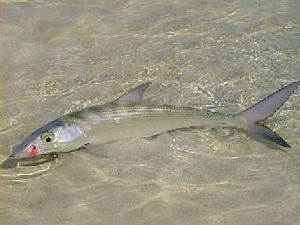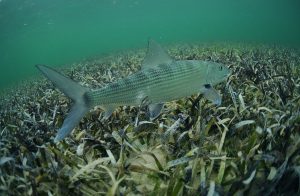It took scientists in Japan more than 50 years to successfully spawn eels in captivity to help preserve the species. In a race to solve a major challenge for conservation aquaculture, a breakthrough by researchers at Florida Atlantic University’s Harbor Branch Oceanographic Institute in collaboration with Bonefish & Tarpon Trust (BTT) is the first in the world to successfully spawn bonefish in captivity – in just four years. Building upon the lessons learned by their scientific colleagues in Japan, FAU Harbor Branch scientists have figured out the life cycle of bonefish in captivity to help inform management and conservation of this revered fishery for the multi-billion dollar sports fishing industry.
A voracious predator Bonefish
Named for the tiny little bones in their body, accelerate faster and sprint farther than any other fish on a light tackle, fight more relentlessly than most fish twice its size, and is considered one of the world’s top fly-fishing targets. These characteristics have made bonefish an extremely valuable component of an economically important recreational fishery in many places they occur, as well as supporting local subsistence fisheries.
 Bonefish are an ancient group of fish, occurring in fossil records going back 138 million years, but large gaps in the knowledge of their biology remain. Information on this “Near Threatened” species, including spawning, eggs, and larvae have remained scarce. Understanding the bonefish life cycle is essential to formulating conservation policies, addressing threats to the fishery and contributing to restoration.
Bonefish are an ancient group of fish, occurring in fossil records going back 138 million years, but large gaps in the knowledge of their biology remain. Information on this “Near Threatened” species, including spawning, eggs, and larvae have remained scarce. Understanding the bonefish life cycle is essential to formulating conservation policies, addressing threats to the fishery and contributing to restoration.
In prior years of the project, FAU Harbor Branch’s pioneering research in bonefish reproductive science has enabled researchers to successfully induce captive bonefish to spawn in aquaculture tanks. From these spawns, they were able to get eggs to hatch and larvae to survive for up to eight days so far. This was the first time that anyone in the world recorded the development of a bonefish embryo, hatching of the egg, and the early larvae.
The new research breakthrough in this project is that bonefish adults held in the laboratory have now been conditioned to produce eggs and milt and then induced to spawn entirely under controlled environmental conditions. In addition, FAU Harbor Branch researchers have been able to reduce the time between spawns to about four months instead of the 12-month natural spawning cycle. This reduced spawning cycle enables more rapid advancement of larval and juvenile developmental biology studies since the research is no longer reliant on waiting for natural spawning once a year.
 “Many marine fish can be raised in captivity without much difficulty, but getting them to spawn in captivity is a much bigger challenge. Due in part to their ancient lineage, bonefish have been an especially difficult challenge,” said Paul Wills, Ph.D., research professor and associate director for research who spearheads the aquaculture and stock enhancement program at FAU’s Harbor Branch. “Prior to this research, we didn’t know the environmental cues bonefish required for spawning; what light, temperature, and salinity levels promote egg and larval development; how long it takes eggs and larvae to develop; what larvae looks like as they develop; or what larvae eat.”
“Many marine fish can be raised in captivity without much difficulty, but getting them to spawn in captivity is a much bigger challenge. Due in part to their ancient lineage, bonefish have been an especially difficult challenge,” said Paul Wills, Ph.D., research professor and associate director for research who spearheads the aquaculture and stock enhancement program at FAU’s Harbor Branch. “Prior to this research, we didn’t know the environmental cues bonefish required for spawning; what light, temperature, and salinity levels promote egg and larval development; how long it takes eggs and larvae to develop; what larvae looks like as they develop; or what larvae eat.”
Because spawning takes place in the open ocean and larvae live there, Wills and Aaron Adams, Ph.D., senior scientist at FAU’s Harbor Branch and director of science and conservation at BTT, lead their team to conduct research with captive bonefish to answer many questions regarding reproduction. Now, they have a hormone profile and road map of how bonefish become ready to spawn, which also is an important metric for evaluating fish in captivity. This information provides a better understanding of the reproductive process in a controlled setting including what healthy eggs should look like and the levels of essential compounds (lipids, fatty acids) that healthy eggs should have.
Twelve Species of Bonefish
Spread around the tropics worldwide they support economically valuable recreational fisheries. The annual economic impacts exceed $465 million in the Florida Keys, $169 million in The Bahamas, and $56 million in Belize. The fishery also is culturally important, with jobs in the fishery often among the best paying and passed along family lines.
“Florida’s recreational and commercial fishing industries and associated businesses account for billions of dollars that drive the economic engine for the state each year and contribute to hundreds of thousands of jobs,” said Jim McDuffie, president and CEO of BTT. “This unique, collaborative project will provide an important tool in our efforts to better understand bonefish, and thus help protect and restore the Florida Keys bonefish fishery.”
Despite the economic importance of bonefish, the fishery is facing challenges due to habitat loss and degradation, coastal development and urbanization, declines in water quality, and harvest by commercial, artisanal and recreational fisheries.
“Bonefish populations have been declining in recent years, with estimates showing a decrease of as much as 90 percent in some areas, including the Florida Keys,” said James Sullivan, Ph.D., executive director, FAU’s Harbor Branch. “Our scientists are close to gaining a full understanding of the bonefish life cycle, which will enable the targeted approach to conservation and restoration that is necessary to ensure the future of the fishery and the economic, social and recreational benefits it provides.”
Aquaculture scientists at FAU’s Harbor Branch embarked on the $3 million grant-funded project in 2016, which was designed to help Florida’s sport fishing industry. The research was funded by a grant from BTT in partnership with the National Fish and Wildlife Foundation. The project is the first-of-its-kind involving the design and testing of an experimental research project to grow bonefish in captivity to understand the bonefish life cycle, which will aid conservation efforts. BTT uses a science-based approach to learn about and identify threats to bonefish, tarpon and permit fisheries in the United States and Caribbean basin and applies a combination of research, stewardship, education and advocacy efforts to address areas of concern.
Knowledge and methodologies gained through the bonefish reproductive study will be shared across the scientific community and with partner agencies charged with fish and wildlife management.
Source: Scientists are First in the World to Spawn Bonefish in Captivity
